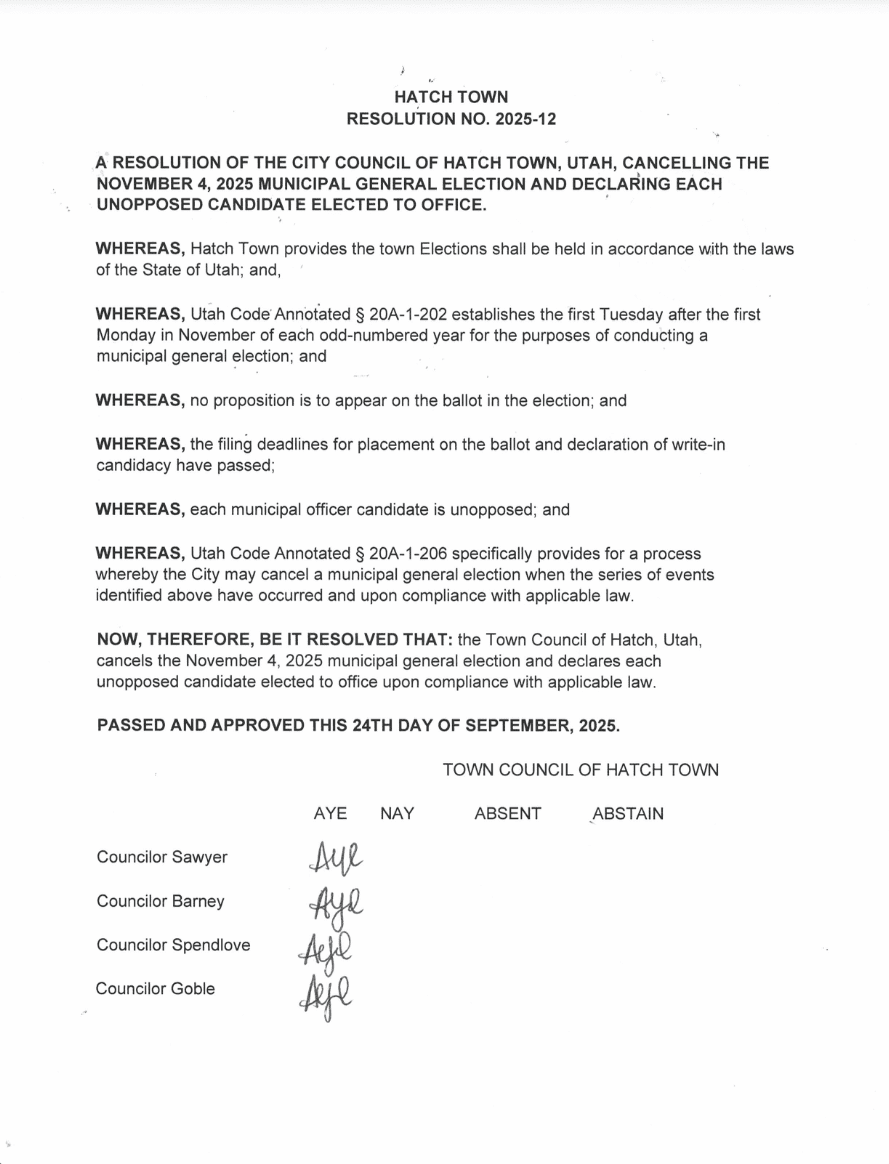IT’S NOT JUST A PLACE
HATCH
IT’S A WAY OF LIFE
Header photo credit: Jolyn Smith
Public Notices
UDOT Passing Lane Update
NOTICE OF OPPORTUNITY FOR PUBLIC HEARING
Proposed Passing Lanes on US-89 near Hatch
The Utah Department of Transportation (UDOT) held a public open house in Hatch, Utah, on June 27, 2024, regarding a proposal to construct northbound and southbound passing lanes on US-89 north of Hatch. Based on public comments received, the originally proposed southbound passing lane between mileposts (MP) 117.3 and 118.3 has been eliminated.
Best Friends Kanab
Community Cat Program
- We will spay/neuter, vaccinate and ear tip any community cat at no charge.
- Then you can take them back to where you found them to live out their happy healthy lives WITHOUT procreating.
Please Call the clinic to schedule an appointment.
435.275.2495
Don’t have any traps? If not, we have traps to loan out.
HATCH TOWN
RESOLUTION NO. 2025-12
A RESOLUTION OF THE CITY COUNCIL OF HATCH TOWN, UTAH, CANCELLING THE NOVEMBER 4 , 2025 MUNICIPAL GENERAL ELECTION AND DECLARING EACH UNOPPOSED CANDIDATE ELECTED TO OFFICE.
SEE THE RESOLUTION BELOW:

Photo credit: Maggie Martinez
Settlement of Hatch
In 1872, Meltiar Hatch settled at the head of the Sevier River near the Junction of Mammoth and Asay Creeks. He engaged in stock raising and operated a water-powered sawmill. Soon, other settlers came; land was surveyed and irrigation ditches dug. Neils P Clove burned lime to make plasters for homes in the area. The first school was in the Hatch home, Abram Workman was the teacher.
During the last decade of the 1800’s a dam was built at the head of the Sevier River known as the Hatchtown Dam. The structure lasted only a short time as the dam broke about 1899 or 1900 (the exact date is not available), and the gushing water came out, taking some homes and other property that stood near the flow of the stream. The weakening condition of the dam gave time for some cautious ones to move their property to higher ground.
In 1888, the Asay Post Office was transferred to Hatch; Neils Ivor Clove was the postmaster. In 1892, the Church of Jesus Christ of Latter Day Saints organized the Mammoth Ward. Aaron Asay was the bishop. In 1899, the ward name was changed to Hatch Ward. From 1901-1901, The Town was moved to the present site under the leadership of Bishop Rosmus Lynn.
History of Hatch
Hatch (Garfield County) is between Panguitch and Long Valley Junction on US-89. In 1872 The Town of Aaron, also called Asay, was settled near the mouth of Asay Creek. Other early settlements in this area along the Sevier River, Asay Creek and Mammoth Creek were Proctor, Castle, Johnson, and Hatchtown. Hatchtown was settled by Meltiar Hatch Sr., and his two wives, Pamella Snyder Hatch and Mary Ann Ellis Hatch.


